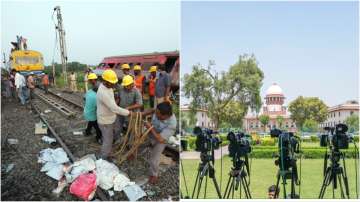A Public interest litigation (PIL) has been filed with the Supreme Court, requesting that a retired Supreme Court judge's expert panel investigate the triple train accident in Odisha's Balasore.
Over 1,000 people have been injured in the Balasore train accident, which involved two passenger trains and a goods carriage. To date, 288 people have died in the incident.
In addition, in order to guarantee public safety, the PIL requested guidelines and instructions for the immediate implementation of the Automatic Train Protection (ATP) System known as the KAVACH Protection System by Indian Railways.
In the event that the loco pilot is unable to do so, "Kavach" automatically applies breaks to control the train's speed.
The PIL that was submitted by advocate Vishal Tiwari stated, "Immediately to set up an expert commission headed by a retired judge of the Supreme Court consisting of technical members to analyse and review the current risk and safety parameters in the railway system and to suggest systematic safety modifications for strengthening Railway safety mechanism and submit its report in two months to this court."
The preliminary report on the misfortune said the three-way mishap included Bengaluru-Howrah Superfast Express, the Coromandel Express and a goods train on three separate tracks at Bahanaga Bazar Station in Balasore district.
In the accident that occurred on Friday evening, as many as 17 coaches of these two passenger trains were severely damaged and derailed.
What is the Kavach system?
The indigenous Automatic Train Protection (ATP) System known as 'Kavach' was announced by the Ministry of Railways on March 23, 2022, as a significant step toward improving train safety in India.
The Research Designs and Standards Organisation (RDSO) developed Kavach with three Indian vendors and made it the National ATP System for Indian Railways.
Kavach was developed to support train operations in adverse weather conditions like dense fog and to assist locomotive pilots in avoiding Signal Passing At Danger (SPAD) and overspeeding.
The system ensures better control over the train's speed and prevents potential accidents by automatically applying brakes when necessary.
The vital elements of the Kavach framework include programmed brake application in case the training pilot neglects to act, and the arrangement of line-side signal display in the lodge for further developed permeability in foggy circumstances.
On the 250-kilometer Lingampally–Vikarabad–Wadi and Vikarabad–Bidar sections of the South Central Railway, Kavach underwent trials. Three vendors were approved for additional development orders on the Indian Railways network after successful trials.
The development of Kavach has cost a total of 16.88 crore rupees.
The New Delhi–Howrah and New Delhi–Mumbai sections of Kavach's rollout are scheduled for completion in March 2024.
The lessons learned from the initial implementation will serve as the foundation for future expansion.
Kavach hit the news after an occurrence in the Balasore locale of Odisha, one of the most devastating train calamities in the chronicles of India's rail line history.
Also Read | Odisha train accident: Root cause 'identified', says Railway Minister Ashwini Vaishnaw
Also Read | Odisha train accident: LIC relaxes claim settlement process for victims | Check details
Latest India News
